What'sNEW
January - March 2016
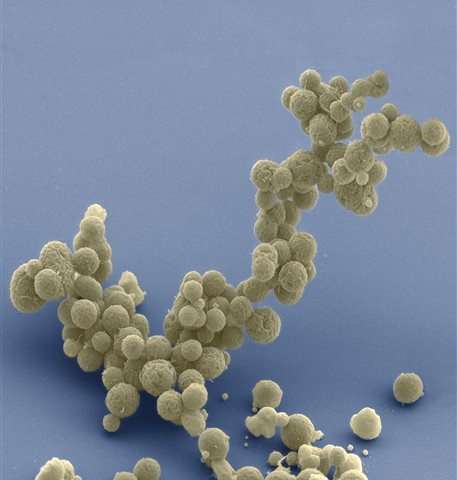 ...we set out to construct a minimal cellular genome in order to experimentally determine a core set of genes for an independently replicating cell. ...Syn3.0 has a 531-kbp genome that encodes 473 gene products.
...we set out to construct a minimal cellular genome in order to experimentally determine a core set of genes for an independently replicating cell. ...Syn3.0 has a 531-kbp genome that encodes 473 gene products.
 Design and synthesis of a minimal bacterial genome, by Clyde A. Hutchison III, Ray-Yuan Chuang et al., doi:10.1126/science.aad6253; and commentary: Synthetic microbe has fewest genes, but many mysteries, by Robert F. Service, v 351, Science, 25 Mar 2016. Design and synthesis of a minimal bacterial genome, by Clyde A. Hutchison III, Ray-Yuan Chuang et al., doi:10.1126/science.aad6253; and commentary: Synthetic microbe has fewest genes, but many mysteries, by Robert F. Service, v 351, Science, 25 Mar 2016.
Astoundingly, Venter says that his team could not identify the function of 149 of the genes in syn3.0's genome, many of which are found in other life forms, including humans.
 Craig Venter's ...methods provide alternative ways to tinker with life's building blocks, by Ewen Callaway, v 531, Nature, 24 Mar 2016. Craig Venter's ...methods provide alternative ways to tinker with life's building blocks, by Ewen Callaway, v 531, Nature, 24 Mar 2016.
 Microbe With Stripped-Down DNA may hint at secrets of life, by Malcolm Ritter, AP Science (+PhysOrg), 24 Mar 2015. Microbe With Stripped-Down DNA may hint at secrets of life, by Malcolm Ritter, AP Science (+PhysOrg), 24 Mar 2015.
 Thanks, Stan Franklin and Michael Paine. Thanks, Stan Franklin and Michael Paine.
 What Is Life? is the main related local webage. What Is Life? is the main related local webage.
 Could Water Have Carved Channels On Mars Half A Million Years Ago? by Elizabeth Howell, Astrobiology Magazine via Phys.org, 19 Mar 2016. Could Water Have Carved Channels On Mars Half A Million Years Ago? by Elizabeth Howell, Astrobiology Magazine via Phys.org, 19 Mar 2016.
 Thanks, Ronnie McGhee. Thanks, Ronnie McGhee.
 Life on Mars! has more about water there. Life on Mars! has more about water there.
| 17 Mar 2016 |
What'sNEW about HGT  | | |
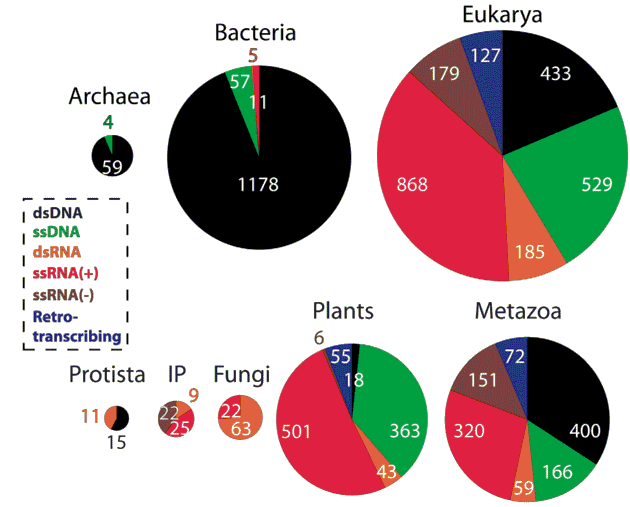 ...Viruses likely initiated major evolutionary shifts.
...Viruses likely initiated major evolutionary shifts.
The pie charts show the observed abundance and distribution of six different kinds of viruses (dashed box) in the three domains of life (top) and among five categories of eukaryotes (bottom).
 The distribution and impact of viral lineages in domains of life by Arshan Nasir, Patrick Forterre, Kyung Mo Kim, and Gustavo Caetano-Anollés:, doi:10.3389/fmicb.2014.00194, Frontiers in Microbiology, 30 Apr 2014. The distribution and impact of viral lineages in domains of life by Arshan Nasir, Patrick Forterre, Kyung Mo Kim, and Gustavo Caetano-Anollés:, doi:10.3389/fmicb.2014.00194, Frontiers in Microbiology, 30 Apr 2014.
 Uneven Distribution of Viruses Suggests Surprising Evolutionary Power by Jennifer Frazer, Scientific American, 11 Mar 2016. Uneven Distribution of Viruses Suggests Surprising Evolutionary Power by Jennifer Frazer, Scientific American, 11 Mar 2016.
 Thanks, Martin Langford. Thanks, Martin Langford.
 Viruses and Other Gene Transfer Mechanisms is the main related local webage. Viruses and Other Gene Transfer Mechanisms is the main related local webage.
 Convergence to Cometary Panspermia: Time for Disclosure? by Chandra Wickramasinghe and Milton Wainwright, doi:10.4172/2332-2519.1000145, Astrobiol & Outreach, 04 Dec 2015. Convergence to Cometary Panspermia: Time for Disclosure? by Chandra Wickramasinghe and Milton Wainwright, doi:10.4172/2332-2519.1000145, Astrobiol & Outreach, 04 Dec 2015.
 Chandra... is a related local webage. Chandra... is a related local webage.
I don't think anybody feels any more confident about how life got going in the first place than they did 30 years ago.
 Sir Patrick Bateson, interviewed about evolution and the Royal Society on HuffPost Science, posted 11 Mar 2016. Sir Patrick Bateson, interviewed about evolution and the Royal Society on HuffPost Science, posted 11 Mar 2016.
 The RNA World and Other Origin-of-Life Theories is the relevant local webpage.. The RNA World and Other Origin-of-Life Theories is the relevant local webpage..
 email to interviewer Suzan Mazur mentions another Bateson and a possible paradigm shift, sent 12 Mar 2016. email to interviewer Suzan Mazur mentions another Bateson and a possible paradigm shift, sent 12 Mar 2016.
| 10 Mar 2016 |
What'sNEW about HGT  | | |
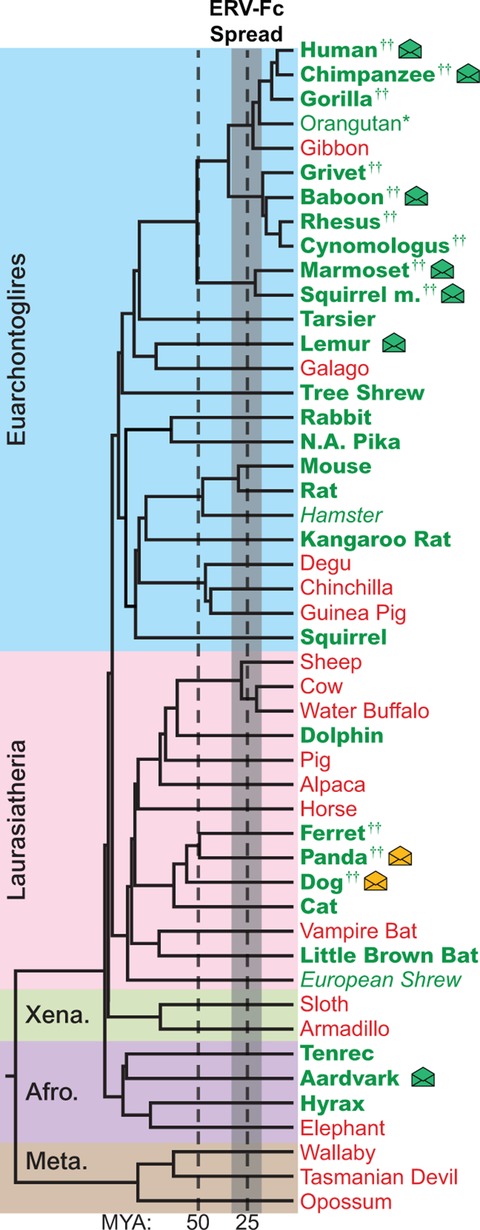 Viruses... have had a significant impact on the evolution of all organisms, from bacteria to humans.
...We uncovered a complex evolutionary history, including a prolonged, ancient global spread of the virus involving multiple instances of cross-species transmission and endogenization.... So write a team at Boston College who used comparative genomics to reconstruct the history of the ERV-Fc family of endogenous retroviruses.
...In most organisms (including humans), ERVs amount to hundreds of thousands of copies per genome....
The distribution of ERV-Fc among different mammals indicates that the viruses spread to every continent except Antarctica and Australia, and that they jumped between species more than 20 times. (Species harboring ERV-Fc are named in green, those lacking it are named in red on the accompanying phylogeny.)
Viruses... have had a significant impact on the evolution of all organisms, from bacteria to humans.
...We uncovered a complex evolutionary history, including a prolonged, ancient global spread of the virus involving multiple instances of cross-species transmission and endogenization.... So write a team at Boston College who used comparative genomics to reconstruct the history of the ERV-Fc family of endogenous retroviruses.
...In most organisms (including humans), ERVs amount to hundreds of thousands of copies per genome....
The distribution of ERV-Fc among different mammals indicates that the viruses spread to every continent except Antarctica and Australia, and that they jumped between species more than 20 times. (Species harboring ERV-Fc are named in green, those lacking it are named in red on the accompanying phylogeny.)
 Tracking interspecies transmission and long-term evolution of an ancient retrovirus using the genomes of modern mammals, William E Diehl et al., doi:10.7554/eLife.12704, 08 Mar 2016. Tracking interspecies transmission and long-term evolution of an ancient retrovirus using the genomes of modern mammals, William E Diehl et al., doi:10.7554/eLife.12704, 08 Mar 2016.
 Scientists Uncover History of Ancient Viruses as Far Back as 30 Million Years Ago, Newswise, 8 Mar 2016. Scientists Uncover History of Ancient Viruses as Far Back as 30 Million Years Ago, Newswise, 8 Mar 2016.
 Viruses and Other Gene Transfer Mechanisms is the main related local webage. Viruses and Other Gene Transfer Mechanisms is the main related local webage.
 Human Genome Search and Human Genome Search and
 New genetic programs... are related local webpages. New genetic programs... are related local webpages.
| 03 Mar 2016 |
What'sNEW about HGT  | | |
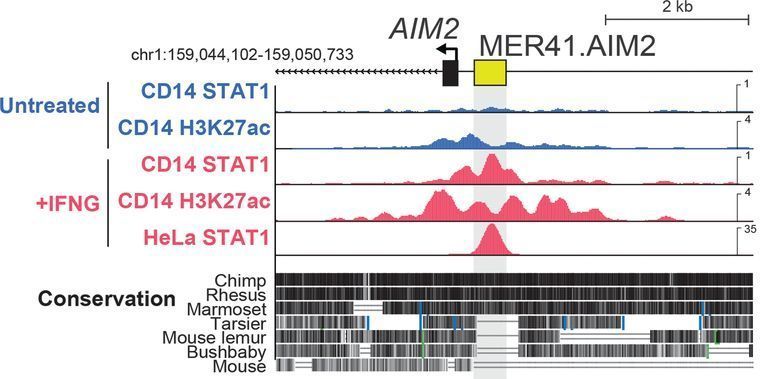 The work suggests that these viral fossils probably played a key role in the evolution of our species....
The work suggests that these viral fossils probably played a key role in the evolution of our species....
 Viral 'fossils' in our DNA may help us fight infection, Monique Brouillette, Science; and: Viral 'fossils' in our DNA may help us fight infection, Monique Brouillette, Science; and:
...Evidence that concerted processes, involving endogenous retroviruses (ERVs), which are remarkably abundant in mammalian genomes, have contributed to the evolution of the regulatory systems that control the mammalian immune system.
 A copy-and-paste gene regulatory network, Vincent J. Lynch, Science; re: A copy-and-paste gene regulatory network, Vincent J. Lynch, Science; re:
Further analysis, including cross-species genomic alignments, confirmed that multiple mammalian lineages were independently colonized by related MER41-like gammaretroviruses ~50 to 75 million years ago.
 Regulatory evolution of innate immunity through co-option of endogenous retroviruses, Edward B. Chuong, Nels C. Elde and Cédric Feschotte, doi:10.1126/science.aad5497, p 1083-1087 v 351, Science, 04 Mar 2016. Regulatory evolution of innate immunity through co-option of endogenous retroviruses, Edward B. Chuong, Nels C. Elde and Cédric Feschotte, doi:10.1126/science.aad5497, p 1083-1087 v 351, Science, 04 Mar 2016.
 Ancient Viral Invaders in Our DNA Help Fight Today's Infections, University of Utah (+Newswise), 3 Mar 2016. Ancient Viral Invaders in Our DNA Help Fight Today's Infections, University of Utah (+Newswise), 3 Mar 2016.
 7-minute Podcast: Feschotte and Chuong explain the research.... 7-minute Podcast: Feschotte and Chuong explain the research.... |
 Viruses..., Viruses...,  Human Genome Search and Human Genome Search and  New genetic programs... are related local webpages. New genetic programs... are related local webpages.
 Beg, Borrow and Steal: Three Aspects of Horizontal Gene Transfer in the Protozoan Parasite, Cryptosporidium parvum, Adam Sateriale and Boris Striepen, doi:10.1371/journal.ppat.1005429, PLOS, 03 Mar 2016. Beg, Borrow and Steal: Three Aspects of Horizontal Gene Transfer in the Protozoan Parasite, Cryptosporidium parvum, Adam Sateriale and Boris Striepen, doi:10.1371/journal.ppat.1005429, PLOS, 03 Mar 2016.
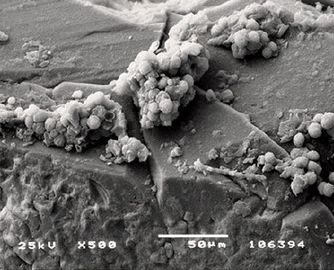
 Antarctic fungi survive Martian conditions on the International Space Station, The Information and Scientific News Service (+astrobio.net +Space.com +Nature), 26 Jan 2016. Antarctic fungi survive Martian conditions on the International Space Station, The Information and Scientific News Service (+astrobio.net +Space.com +Nature), 26 Jan 2016.
 Survival of Antarctic Cryptoendolithic Fungi in Simulated Martian Conditions On Board the International Space Station, Silvano Onofri et al., doi:10.1089/ast.2015.1324, Astrobiology, 18 Dec 2015. Survival of Antarctic Cryptoendolithic Fungi in Simulated Martian Conditions On Board the International Space Station, Silvano Onofri et al., doi:10.1089/ast.2015.1324, Astrobiology, 18 Dec 2015.
 Thanks, Ronnie McGhee and PAW. Thanks, Ronnie McGhee and PAW.
 Life on Mars! is a related local webpage. Life on Mars! is a related local webpage.
Comet 67P has a bulk density of .533 ±.006, according to ESA. This is consistent with the estimated density of comet 9P/Tempel 1. ESA concludes that the interior of the nucleus is homogeneous and constant in density on a global scale without large voids. The high porosity seems to be an inherent property of the nucleus material. The low density of comets especially interests us because many of the fragments of the Polonnaruwa meteorite that fell 29 Dec 2012, in Sri Lanka, had densities of ~.6. Very few species of terrestrial rocks have densities less than one, and Polonnaruwa is clearly unlike any of them. Yet the Meteoritical Society still has not recognized Polonnaruwa as a meteorite.
 A homogeneous nucleus for comet 67P/Churyumov-Gerasimenko from its gravity field by M. Pätzold et al., doi:10.1038/nature16535, p 63-65 v 530, Nature, 4 Feb 2016. A homogeneous nucleus for comet 67P/Churyumov-Gerasimenko from its gravity field by M. Pätzold et al., doi:10.1038/nature16535, p 63-65 v 530, Nature, 4 Feb 2016.
 A carbonaceous meteorite that fell in Sri Lanka..., our first posting about Polonnaruwa, 11 Jan 2013. A carbonaceous meteorite that fell in Sri Lanka..., our first posting about Polonnaruwa, 11 Jan 2013.
...You have thousands of dead genes scattered throughout your genome, and some of them are just itching to spring back to life. — Kat Arney, chapter 15
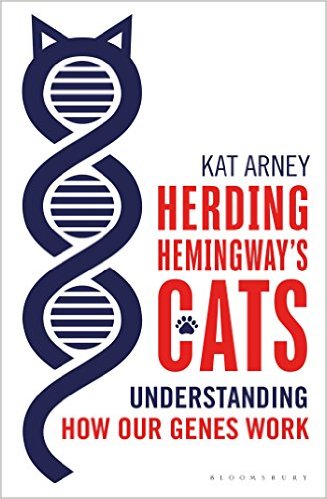 A normal eukaryotic gene contains introns, irrelevant interruptions analogous to TV commercials. After the gene is transcribed into RNA, the introns are spliced out: no commercials. Then it gets translated through a ribosome into a functioning polypeptide. However, instead, occasionally, the intronless mRNA is reverse-transcribed back into DNA, making a processed pseudogene. You could say that the software that manages eukaryotic genomes has a way to defragment and streamline genes. Why this happens is a puzzle for darwinism, and all pseudogenes used to be classified as "junk". In fact, the human genome contains more than 10,000 of them, and some are active. A new book based on interviews with leading genomicists considers this and other current enigmas, in plain, welcome language.
A normal eukaryotic gene contains introns, irrelevant interruptions analogous to TV commercials. After the gene is transcribed into RNA, the introns are spliced out: no commercials. Then it gets translated through a ribosome into a functioning polypeptide. However, instead, occasionally, the intronless mRNA is reverse-transcribed back into DNA, making a processed pseudogene. You could say that the software that manages eukaryotic genomes has a way to defragment and streamline genes. Why this happens is a puzzle for darwinism, and all pseudogenes used to be classified as "junk". In fact, the human genome contains more than 10,000 of them, and some are active. A new book based on interviews with leading genomicists considers this and other current enigmas, in plain, welcome language.
 Herding Hemingway's Cats: Understanding how our genes work by Kat Arney, ISBN:9781472910066, Bloomsbury Sigma, 14 Jan 2016. Herding Hemingway's Cats: Understanding how our genes work by Kat Arney, ISBN:9781472910066, Bloomsbury Sigma, 14 Jan 2016.
 Introns: A Mystery is a related CA webpage. Introns: A Mystery is a related CA webpage.
 Book Reviews Book Reviews
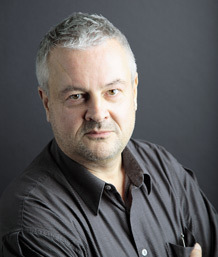 ...There's a reasonable fear that if you approach evolution from the point of the absolutely extraordinary things that people have discovered about the microbial world in the last 20 or 30 years, you'll begin to jeopardize communication.
— Philosopher of science John Dupré (pictured) on the agenda for an upcoming meeting about the need for major changes in the theory of evolution.
...There's a reasonable fear that if you approach evolution from the point of the absolutely extraordinary things that people have discovered about the microbial world in the last 20 or 30 years, you'll begin to jeopardize communication.
— Philosopher of science John Dupré (pictured) on the agenda for an upcoming meeting about the need for major changes in the theory of evolution.
...What's clear to me is that we do not have a good understanding of evolutionary novelty and evolutionary change. There are many things that we know have the potential to provide sources for evolutionary change. To me one of the most exciting areas there is a better understanding of the role of microbes and viruses in providing novelty....
 Interview with Suzan Mazur, HuffPost Science, online 08 Feb 2016. Interview with Suzan Mazur, HuffPost Science, online 08 Feb 2016.
 New trends in evolutionary biology, the Royal Society meeting in London, 7-9 Nov 2016. New trends in evolutionary biology, the Royal Society meeting in London, 7-9 Nov 2016.
 Viruses and Other Gene Transfer Mechanisms are a primary subject of the interview. Viruses and Other Gene Transfer Mechanisms are a primary subject of the interview.
 Reply to Mazur, 9 Feb. Reply to Mazur, 9 Feb.
| 04 Feb 2016 |
What'sNEW about HGT  | | |
The bed bug genome contains more than 800 genes that apparently come from bacteria according to a collaboration among researchers from 36 institutions. More evidence of cross-kingdom Horizontal Gene Transfer. And a vector for continued transfer, to the bedbug's host?!

 Scientists map genome of common bed bug, University of Rochester (+Newswise), 2 Feb 2016. Scientists map genome of common bed bug, University of Rochester (+Newswise), 2 Feb 2016.
 Viruses and Other Gene Transfer Mechanisms is the main related local webpage. Viruses and Other Gene Transfer Mechanisms is the main related local webpage.
Does the Gaian bottleneck solve Fermi's paradox? A pair of planetary scientists at the Australian National University, Canberra, believe it does. First, they think that life starts easily on wet rocky planets, of which there are plenty. "The prerequisites and ingredients for life seem to be abundantly available in the Universe."
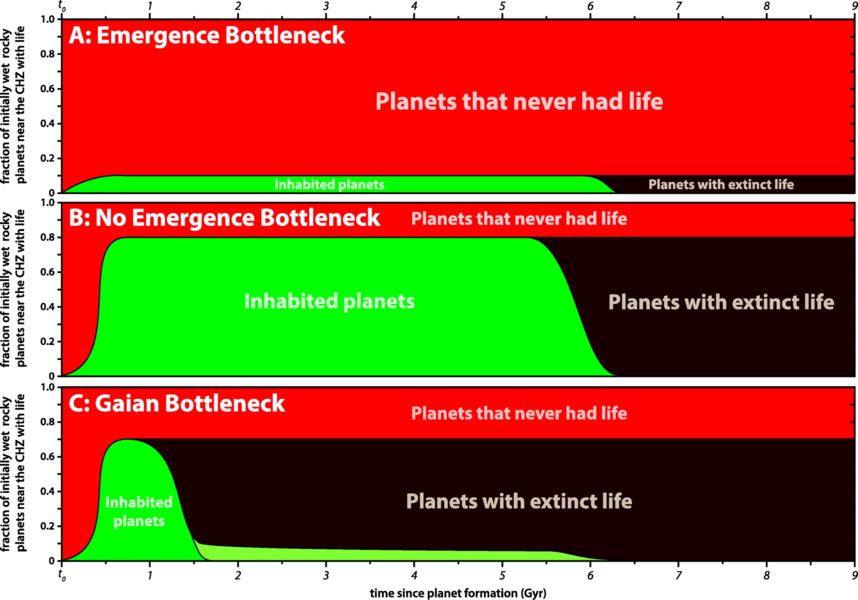
But runaway positive feedback loops, either greenhouse heating or glaciation-albedo freezing, soon render most planets uninhabitable.
"...If life emerges on a planet, it only rarely evolves quickly enough to regulate greenhouse gases and albedo...."
Venus is a likely example of the greenhouse catastrophe, finally losing its water to dissociation by UV radiation in the upper atmosphere. And Mars may exemplify the freezing scenario, eventually losing most of its water, too.
They call lethal outcomes like these, collectively, the "Gaian bottleneck." It is a new way to explain why "the Universe does not seem to be teeming with life." (Actually, we think the universe may be teeming with microbial life, but SETI, at least, has not found any advanced life.)
The two scientists never mention panspermia, but it would make the emergence of life elsewhere even more likely than they suppose. And we think that the genetic programming for life with Gaian stabilizing feedback loops is readily available and need not wait until strictly darwinian evolution may compose it. So, logically, Fermi's paradox is an even bigger puzzle for cosmic ancestry. The barriers to long-lasting, highly evolved life must be formidable.
We think the two Australians deserve an audience. We like their firm predictions, unfettered speculations, and noteworthy observations, like, "The existence of liquid water on the surface of a planet may be a better biosignature than oxygen...." Their article is thought-provoking, well-referenced and currently available on the Internet.
| In the first billion years on a wet rocky planet in the Universe, impacts and an inability to control surface environments are usually not just frustrating, but fatal.
|
 The Case for a Gaian Bottleneck: The Biology of Habitability by Aditya Chopra and Charles H. Lineweaver, doi:10.1089/ast.2015.1387, p 7-22 v 16, Astrobiology
(+Researchgate), Jan 2016. The Case for a Gaian Bottleneck: The Biology of Habitability by Aditya Chopra and Charles H. Lineweaver, doi:10.1089/ast.2015.1387, p 7-22 v 16, Astrobiology
(+Researchgate), Jan 2016.
 "The aliens are silent because they are extinct," the Australian National University via Newswise, 21 Jan 2016. "The aliens are silent because they are extinct," the Australian National University via Newswise, 21 Jan 2016.
 Gaia and Gaia and  Introduction... are related CA webpages. Introduction... are related CA webpages.
 Sacha Wageringel comments on Fermi's paradox, 11 Feb 2016. Sacha Wageringel comments on Fermi's paradox, 11 Feb 2016.
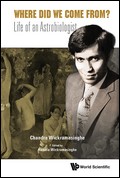 Where Did We Come From? is Chandra Wickramasinghe's new autobiography. We were captivated by this plainly-told story of his scientific career. Chandra is naturally conservative, but his research took him far from the existing orthodoxy. "My life's work in astronomy first sought to discover what cosmic dust is made of. And from such a seemingly innocent project I went on to argue that cosmic dust was connected with life itself." The story weaves the progress of his research together with his family and personal history, and includes mention of many collaborators, Fred Hoyle being foremost among them. We especially like the boldness and integrity by which he arrived at his biggest breakthrough. "...We had a situation totally different from anything we had experienced previously. ...The result was staggering: We had discovered a perfect fit to the average interstellar extinction over the visual waveband with just one assumption — that interstellar grains were freeze-dried bacteria."
Where Did We Come From? is Chandra Wickramasinghe's new autobiography. We were captivated by this plainly-told story of his scientific career. Chandra is naturally conservative, but his research took him far from the existing orthodoxy. "My life's work in astronomy first sought to discover what cosmic dust is made of. And from such a seemingly innocent project I went on to argue that cosmic dust was connected with life itself." The story weaves the progress of his research together with his family and personal history, and includes mention of many collaborators, Fred Hoyle being foremost among them. We especially like the boldness and integrity by which he arrived at his biggest breakthrough. "...We had a situation totally different from anything we had experienced previously. ...The result was staggering: We had discovered a perfect fit to the average interstellar extinction over the visual waveband with just one assumption — that interstellar grains were freeze-dried bacteria."
 Where Did We Come From? Life of an Astrobiologist by Chandra Wickramasinghe, edited by Kamala Wickramasinghe, 236 pages, ISBN:978-981-4641-39-5, World Scientific, Mar 2015. Where Did We Come From? Life of an Astrobiologist by Chandra Wickramasinghe, edited by Kamala Wickramasinghe, 236 pages, ISBN:978-981-4641-39-5, World Scientific, Mar 2015.
 Chandra Wickramasinghe is a related CA webpage. Chandra Wickramasinghe is a related CA webpage.
 Book Reviews Book Reviews
| 22 Jan 2016 |
What'sNEW about HGT  | | |
...Viruses might just have had a hand in making us who we are.
 How giant viruses could rewrite the story of life on Earth by Garry Hamilton, New Scientist, 20 Jan 2016. How giant viruses could rewrite the story of life on Earth by Garry Hamilton, New Scientist, 20 Jan 2016.
 Viruses and Other Gene Transfer Mechanisms is the main related CA webpage. Viruses and Other Gene Transfer Mechanisms is the main related CA webpage.
 Developments in evolutionary biology and adjacent fields have produced calls for revision of the standard theory of evolution, although the issues involved remain hotly contested. This meeting [7-9 Nov 2016] will present these developments and arguments in a form that will encourage cross-disciplinary discussion ...and explore the social and philosophical implications. — The Royal Society, London.
Developments in evolutionary biology and adjacent fields have produced calls for revision of the standard theory of evolution, although the issues involved remain hotly contested. This meeting [7-9 Nov 2016] will present these developments and arguments in a form that will encourage cross-disciplinary discussion ...and explore the social and philosophical implications. — The Royal Society, London.
 Thanks, Suzan Mazur. Thanks, Suzan Mazur.
 New trends in evolutionary biology...: the meeting announcement. New trends in evolutionary biology...: the meeting announcement.
"No other scientific question [than the origin of life] has... so often stripped science of its veneer of objectivity."
 Bill Mesler and H. James Cleaves II, A Brief History of Creation Science and the Search for the Origin of Life, ISBN-13: 978-0393083552, W.W. Norton & Co. Inc., 2016. Bill Mesler and H. James Cleaves II, A Brief History of Creation Science and the Search for the Origin of Life, ISBN-13: 978-0393083552, W.W. Norton & Co. Inc., 2016.
 The RNA World... discusses origin-of-life research. The RNA World... discusses origin-of-life research.
 Evolution vs Creationism is a related local webpage. Evolution vs Creationism is a related local webpage.
| 04 Jan 2016 |
What'sNEW about HGT  | | |
Thousands of human and/or chimpanzee-specific genes are derived from previously silent DNA, according to geneticists at Spanish and Dutch research institutions, in research newly published in PLoS. So called de novo genes were already known, but not to this extent among humans and chimps.
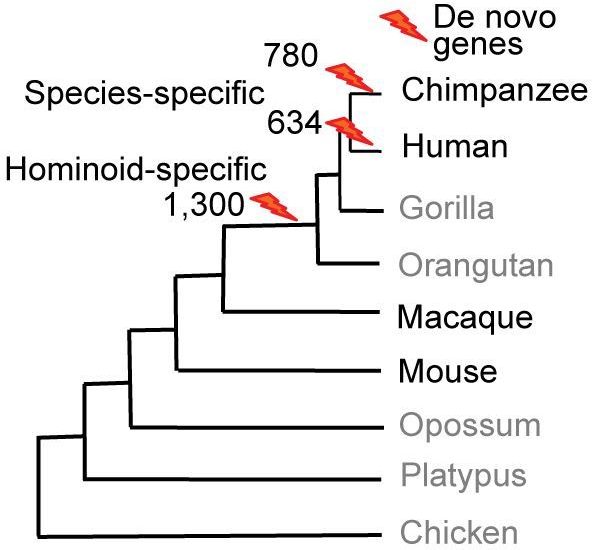
"...We identified 2,714 genes which were specific of human, chimpanzee, or their hominoid ancestor. ...These genes lacked homologues in other species after exhaustive searches...." |
The researchers observe that silent DNA is unconstrained and therefore free to explore the entire available sequence space. But these de novo genes "had a median size of 595 nucleotides." That length of DNA has c. 10^358 possible sequences. Not one quintillionth, 10^340, of that sequence space could have been explored within the consensus big-bang universe. Darwinism cannot account for these genes.
Cosmic ancestry, however, expects genetic programming to precede its own expression, as de novo genes demonstrate. These programs may be delivered by various means of horizontal gene transfer (HGT). Then they may be toggled on by point mutations, or switched on by new regulatory sequences also coming from HGT, then tested, and eventually retained-or-not by natural selection. From the report:
"...In every genome there are sets of genes which are unique to that particular species i.e. lacking homologues in any other species. How have these genes originated?"
"...We have found thousands of transcripts that are human and/or chimpanzee-specific and which are likely to have originated de novo from previously non-transcribed regions of the genome. We have observed an enrichment in transcription factor binding sites in the promoter regions of these genes when compared to other species; this is consistent with the idea that the gain of new regulatory motifs results in de novo gene expression. We also show that some of the genes encode new functional proteins expressed in brain or testis, which may have contributed to phenotypic novelties in human evolution."
"Our analysis was based on multiexonic genes but we have to consider that many recently evolved genes may not have yet acquired the capacity to be spliced.... Therefore, there are probably many more de novo genes than those studied here. The de novo genes constituted about 4% of all expressed multiexonic genes in human and chimpanzee."
"Several studies have found an excess of genes of very recent origin when compared to older gene classes. This suggests that many young genes are subsequently lost, which is consistent with the relatively constant number of genes observed in a taxon. Our finding that signatures of purifying selection are generally very weak for de novo genes is indeed consistent with a scenario in which many of these genes are dispensable. However, a subset of genes with evidence of translation do display significant signatures of purifying selection, indicating that they correspond to functional genes."
 Origins of De Novo Genes in Human and Chimpanzee by Ruiz-Orera J, Hernandez-Rodriguez J, Chiva C, Sabidó E, Kondova I, Bontrop R, et al., doi:10.1371/journal.pgen.1005721, PLoS Genet, 31 Dec 2015. Origins of De Novo Genes in Human and Chimpanzee by Ruiz-Orera J, Hernandez-Rodriguez J, Chiva C, Sabidó E, Kondova I, Bontrop R, et al., doi:10.1371/journal.pgen.1005721, PLoS Genet, 31 Dec 2015.
 Viruses and Other Gene Transfer Mechanisms is the main CA webpage about Horizontal Gene Transfer (HGT). Viruses and Other Gene Transfer Mechanisms is the main CA webpage about Horizontal Gene Transfer (HGT).
 New genetic programs in Darwinism and strong panspermia, New genetic programs in Darwinism and strong panspermia,
 Conserved Non-Genic Sequences and Conserved Non-Genic Sequences and
 A Wordcount for Comparison are related webpages. A Wordcount for Comparison are related webpages.
 Three New Human Genes has an example and updates about de novo genes. Three New Human Genes has an example and updates about de novo genes.
 New genetic programs in Darwinism and strong panspermia (2002) asked where human genes come from. New genetic programs in Darwinism and strong panspermia (2002) asked where human genes come from.
 4 Sep 2015: We discuss an earlier version of this report. 4 Sep 2015: We discuss an earlier version of this report.
 Thanks again, Ken Jopp. Thanks again, Ken Jopp.
 21 Aug 2016: Can antagonistic evolution compose de novo genes? 21 Aug 2016: Can antagonistic evolution compose de novo genes?
![]()
|
 ...we set out to construct a minimal cellular genome in order to experimentally determine a core set of genes for an independently replicating cell. ...Syn3.0 has a 531-kbp genome that encodes 473 gene products.
...we set out to construct a minimal cellular genome in order to experimentally determine a core set of genes for an independently replicating cell. ...Syn3.0 has a 531-kbp genome that encodes 473 gene products.
 ...Viruses likely initiated major evolutionary shifts.
...Viruses likely initiated major evolutionary shifts.
 Viruses... have had a significant impact on the evolution of all organisms, from bacteria to humans.
...We uncovered a complex evolutionary history, including a prolonged, ancient global spread of the virus involving multiple instances of cross-species transmission and endogenization.... So write a team at Boston College who used comparative genomics to reconstruct the history of the ERV-Fc family of endogenous retroviruses.
...In most organisms (including humans), ERVs amount to hundreds of thousands of copies per genome....
The distribution of ERV-Fc among different mammals indicates that the viruses spread to every continent except Antarctica and Australia, and that they jumped between species more than 20 times. (Species harboring ERV-Fc are named in green, those lacking it are named in red on the accompanying phylogeny.)
Viruses... have had a significant impact on the evolution of all organisms, from bacteria to humans.
...We uncovered a complex evolutionary history, including a prolonged, ancient global spread of the virus involving multiple instances of cross-species transmission and endogenization.... So write a team at Boston College who used comparative genomics to reconstruct the history of the ERV-Fc family of endogenous retroviruses.
...In most organisms (including humans), ERVs amount to hundreds of thousands of copies per genome....
The distribution of ERV-Fc among different mammals indicates that the viruses spread to every continent except Antarctica and Australia, and that they jumped between species more than 20 times. (Species harboring ERV-Fc are named in green, those lacking it are named in red on the accompanying phylogeny.)
 The work suggests that these viral fossils probably played a key role in the evolution of our species....
The work suggests that these viral fossils probably played a key role in the evolution of our species....

 A normal eukaryotic gene contains introns, irrelevant interruptions analogous to TV commercials. After the gene is transcribed into RNA, the introns are spliced out: no commercials. Then it gets translated through a ribosome into a functioning polypeptide. However, instead, occasionally, the intronless mRNA is reverse-transcribed back into DNA, making a processed pseudogene. You could say that the software that manages eukaryotic genomes has a way to defragment and streamline genes. Why this happens is a puzzle for darwinism, and all pseudogenes used to be classified as "junk". In fact, the human genome contains more than 10,000 of them, and some are active. A new book based on interviews with leading genomicists considers this and other current enigmas, in plain, welcome language.
A normal eukaryotic gene contains introns, irrelevant interruptions analogous to TV commercials. After the gene is transcribed into RNA, the introns are spliced out: no commercials. Then it gets translated through a ribosome into a functioning polypeptide. However, instead, occasionally, the intronless mRNA is reverse-transcribed back into DNA, making a processed pseudogene. You could say that the software that manages eukaryotic genomes has a way to defragment and streamline genes. Why this happens is a puzzle for darwinism, and all pseudogenes used to be classified as "junk". In fact, the human genome contains more than 10,000 of them, and some are active. A new book based on interviews with leading genomicists considers this and other current enigmas, in plain, welcome language.
 ...There's a reasonable fear that if you approach evolution from the point of the absolutely extraordinary things that people have discovered about the microbial world in the last 20 or 30 years, you'll begin to jeopardize communication.
— Philosopher of science John Dupré (pictured) on the agenda for an upcoming meeting about the need for major changes in the theory of evolution.
...There's a reasonable fear that if you approach evolution from the point of the absolutely extraordinary things that people have discovered about the microbial world in the last 20 or 30 years, you'll begin to jeopardize communication.
— Philosopher of science John Dupré (pictured) on the agenda for an upcoming meeting about the need for major changes in the theory of evolution.

 Where Did We Come From? is Chandra Wickramasinghe's new autobiography. We were captivated by this plainly-told story of his scientific career. Chandra is naturally conservative, but his research took him far from the existing orthodoxy. "My life's work in astronomy first sought to discover what cosmic dust is made of. And from such a seemingly innocent project I went on to argue that cosmic dust was connected with life itself." The story weaves the progress of his research together with his family and personal history, and includes mention of many collaborators, Fred Hoyle being foremost among them. We especially like the boldness and integrity by which he arrived at his biggest breakthrough. "...We had a situation totally different from anything we had experienced previously. ...The result was staggering: We had discovered a perfect fit to the average interstellar extinction over the visual waveband with just one assumption — that interstellar grains were freeze-dried bacteria."
Where Did We Come From? is Chandra Wickramasinghe's new autobiography. We were captivated by this plainly-told story of his scientific career. Chandra is naturally conservative, but his research took him far from the existing orthodoxy. "My life's work in astronomy first sought to discover what cosmic dust is made of. And from such a seemingly innocent project I went on to argue that cosmic dust was connected with life itself." The story weaves the progress of his research together with his family and personal history, and includes mention of many collaborators, Fred Hoyle being foremost among them. We especially like the boldness and integrity by which he arrived at his biggest breakthrough. "...We had a situation totally different from anything we had experienced previously. ...The result was staggering: We had discovered a perfect fit to the average interstellar extinction over the visual waveband with just one assumption — that interstellar grains were freeze-dried bacteria."
 Developments in evolutionary biology and adjacent fields have produced calls for revision of the standard theory of evolution, although the issues involved remain hotly contested. This meeting [7-9 Nov 2016] will present these developments and arguments in a form that will encourage cross-disciplinary discussion ...and explore the social and philosophical implications. — The Royal Society, London.
Developments in evolutionary biology and adjacent fields have produced calls for revision of the standard theory of evolution, although the issues involved remain hotly contested. This meeting [7-9 Nov 2016] will present these developments and arguments in a form that will encourage cross-disciplinary discussion ...and explore the social and philosophical implications. — The Royal Society, London.
